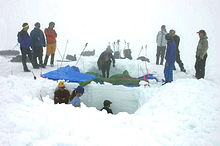Snowpack is an accumulation of snow that compresses with time and melts seasonally, often at high elevation or high latitude.[1][2] Snowpacks are an important water resource that feed streams and rivers as they melt, sometimes leading to flooding. Snowpacks provide water to down-slope communities for drinking and agriculture.[3] High-latitude or high-elevation snowpacks contribute mass to glaciers in their accumulation zones, where annual snow deposition exceeds annual melting.[4]

Assessing the formation and stability of snowpacks is important in the study and prediction of avalanches.[5][6] Scientists study the physical properties of snow under different conditions and their evolution, and more specifically snow metamorphism,[7][8] snow hydrology (that is, the contribution of snow melt to catchment hydrology), the evolution of snow cover with climate change and its effect on the ice–albedo feedback and hydrology, both on the ground and by using remote sensing.[9] Snow is also studied in a more global context of impact on animal habitats and plant succession.[10] An important effort is put into snow classification, both as a hydrometeor[11] and on the ground.[12]
Scientific applications
editSnowpack modeling is done for snow stability, flood forecasting, water resource management, and climate studies.[13] Snowpack modeling is either done by simple, statistical methods such as degree day or complex, physically based energy balance models such as SNOWPACK, CROCUS or SNOWMODEL.[14][15][16]
See also
editReferences
edit- ^ "Definition of SNOWPACK". www.merriam-webster.com. 2024-02-25. Retrieved 2024-03-07.
- ^ "Definition of 'snowpack'". Collins English Dictionary. Retrieved 2024-03-06.
- ^ "Snowpack". education.nationalgeographic.org. Retrieved 2024-03-07.
- ^ "Science of Glaciers". National Snow and Ice Data Center. Retrieved 2024-03-07.
- ^ Cox, Steven M.; Fulsaas, Kris. Mountaineering. Mountaineers Books. pp. 346–347. ISBN 9781594851292.
- ^ Tobias Kurzeder, Holger Feist, Powderguide: Managing Avalanche Risk, Mountain Sports Press, 978-0972482738, 190 pages
- ^ Pinzer, B. R., Schneebeli, M., and Kaempfer, T. U.(2012) "Vapor flux and recrystallization during dry snow metamorphism under a steady temperature gradient as observed by time-lapse micro-tomography", TheCryosphere, 6, 1141–1155, doi:10.5194/tc-6-1141-2012
- ^ Lehning, Michael. "Fresh insights into snow metamorphism". WSL Institute for Snow and Avalanche Research SLF. Archived from the original on Sep 4, 2017.
- ^ Mousavi, Seyedmohammad (2016). "Dry snowpack and freshwater icepack remote sensing using wideband Autocorrelation radiometry". 2016 IEEE International Geoscience and Remote Sensing Symposium (IGARSS). pp. 5288–5291. doi:10.1109/IGARSS.2016.7730377. ISBN 978-1-5090-3332-4. S2CID 23975901.
- ^ Santeford, Henry S.; Smith, James Leroy (January 1974). Advanced Concepts and Techniques in the Study of Snow and Ice Resources: An Interdisciplinary Symposium; [papers]. National Academy of Sciences. p. 273. ISBN 9780309022354.
- ^ Libbrecht, Kenneth G. "Snowflakes and Snow Crystals". www.its.caltech.edu.
- ^ "IACS". www.cryosphericsciences.org.
- ^ Oliver, John E. (2008-04-23). Encyclopedia of World Climatology. Springer. p. 660. ISBN 9781402032646.
- ^ Morin, Samuel; Horton, Simon; Techel, Frank; Bavay, Mathias; Coléou, Cécile; Fierz, Charles; Gobiet, Andreas; Hagenmuller, Pascal; Lafaysse, Matthieu; Ližar, Matjaž; Mitterer, Christoph; Monti, Fabiano; Müller, Karsten; Olefs, Marc; Snook, John S. (2020-02-01) [2019-10-30]. "Application of physical snowpack models in support of operational avalanche hazard forecasting: A status report on current implementations and prospects for the future". Cold Regions Science and Technology. 170 (published 2019-10-30): 102910. doi:10.1016/j.coldregions.2019.102910.
- ^ Viallon-Galinier, Léo; Hagenmuller, Pascal; Lafaysse, Matthieu (2020-12-01). "Forcing and evaluating detailed snow cover models with stratigraphy observations". Cold Regions Science and Technology. 180: 103163. Bibcode:2020CRST..18003163V. doi:10.1016/j.coldregions.2020.103163. ISSN 0165-232X.
- ^ Liston, Glen E.; Elder, Kelly (2006). "A distributed snow-evolution modeling system (SnowModel)". Journal of Hydrometeorology. 7 (6): 1259–1276. Bibcode:2006JHyMe...7.1259L. doi:10.1175/JHM548.1.